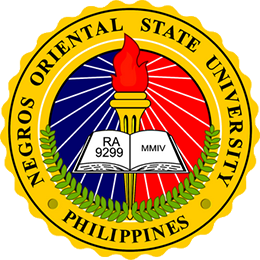
Cebu City, officially the City of Cebu, is a highly urbanized city in the Central Visayas region of the Philippines. According to the 2020 census, it has a population of 964,169 people, making it the sixth-most populated city in the nation and the most populous in the Visayas and in Central Visayas Region.

Sergio Osmeña Sr. was a Filipino lawyer and politician who served as the fourth President of the Philippines from 1944 to 1946. He was Vice President under Manuel L. Quezon. Upon Quezon's sudden death in 1944, Osmeña succeeded him at age 65, becoming the oldest person to assume the Philippine presidency until Rodrigo Duterte took office in 2016 at age 71. A founder of the Nacionalista Party, Osmeña was also the first Visayan to become president.

Negros Oriental State University is a public/state nonsectarian higher education institution in Dumaguete, Philippines. It was founded in 2004 by virtue of RA 9299. It is the only state university in the province of Negros Oriental, Philippines. Its Main Campus is located in Dumaguete and has the most number of academic programs and student organizations. It also has 6 satellite campuses all over the province. Formerly Central Visayas Polytechnic College, it was converted into a state university for students from Visayas and Mindanao.

Cebu Normal University, also referred to by its acronym CNU, is a state research university in Cebu City, Cebu, Philippines established in 1902.
Cebu City National Science High School, commonly known as Sci-Hi or Science High, is one of the pioneering science schools in Cebu City, Philippines.

Bukidnon State University, abbreviated as BSU and colloquially referred to as BukSU, is a provincial state university in Malaybalay City, Bukidnon, Philippines. Formerly named Bukidnon State College, it became a university in 2007. The other university in the province of Bukidnon is Central Mindanao University in Musuan, Maramag.

Cavite National High School (Filipino: Pambansang Mataas na Paaralan ng Cavite) formerly known as Cavite High School is a Secondary school located at the City of Cavite in the Philippines. It was established on June 19, 1902, and it is the first and oldest national secondary school in the Philippines.

Don Vicente Rama Memorial National High School is a public secondary school in Cebu City in the Philippines.

Negros Occidental High School is a public secondary educational institution and oldest public secondary school in the province located in Bacolod, Negros Occidental, in the Philippines that was founded since 1902. The school currently offers various curriculum: Special Program in Science Technology, Engineering and Mathematics (STEM) for the Special Science Class, Basic Education Curriculum for the Regular Class, Special Program for the Arts, Special Program in Journalism, Special Class in Culture and Sports and the Basic Education Curriculum for the Night Class. The Negros Occidental High School had an Extension campus in Murcia, Negros Occidental and later on changed its name to Murcia National High School

Tomás Lluisma Cabili was a Filipino lawyer, journalist, educator, and assemblyman from Lanao. He was also known as "Sultan Dimasangkay-ko-Ranao" for Maranaos.

College of Technological Sciences – Cebu is a mid-sized educational institution currently located at Corner R.R. Rallos Street and N. Bacalso Avenue, Cebu City, Philippines. It is the sister school of University of Cebu.

Sacred Heart School – Ateneo de Cebu (SHS-AdC), formerly known as Sacred Heart School for Boys (SHS-B), is a private, Catholic, Chinese-Filipino college-preparatory, K-12 school run by the Philippine Province of the Society of Jesus in Mandaue City, Philippines. It was established in 1955 with a curriculum that includes a Chinese language course.
The Batanes National Science High School, formerly the Batanes National High School, is a public science high school in the Philippines, recognized by the Department of Education. It is in Basco, the provincial capital of Batanes, and had an enrollment of 1,112 students in school year 2022–2023. The current principal is Carmen C. Noguera.

The Cebu Provincial Capitol is the seat of the provincial government of Cebu in the Philippines. Located at the north end of Osmeña Boulevard in Cebu City, it was designed by Juan M. Arellano, a Filipino architect best known for the Manila Metropolitan Theater (1935), the Legislative Building, and the Manila Central Post Office (1926). An inscription on the central concave portion of its façade reads, "The authority of the government emanates from the people. Erected A.D. MCMXXXVII."

Cebu Technological University, abbreviated as CTU and also known as Cebu Tech, is a public, non-sectarian, coeducational, state-funded higher education institution located in Cebu, Philippines. CTU was originally a part of the Philippine public high school system and traces its roots to the Manual Arts department of the Cebu Normal School, and was founded independently in 1911 as the Cebu Trade School. In 1928, the institution opened its own campus near the Port of Cebu, where its main campus still stands today.

The Camarines Sur National High School, also called CamHi, is the oldest national high school in Camarines Sur and one of the biggest public secondary schools in the Bicol Region, Philippines, having a student population of 11,899 in the school year 2021–2022. It was established in 1902.

Samar National School (SNS) is the mother school of the province of Samar, under the Catbalogan Division, Philippines located in its capital city, Catbalogan that was founded in 1904.

Osmeña Boulevard is a major arterial thoroughfare in Cebu City, Philippines. It is the city's "main street" which travels in a generally northwest–southeast orientation linking the old downtown district of San Roque near the harbor with the modern uptown Capitol Site district. Beginning at M.J. Cuenco Avenue in the east, the boulevard heads northwest towards Fuente Osmeña circle and ends at Escario Street. At its north end, the Cebu Provincial Capitol serves as a prominent terminating vista. It is the location of many of Cebu's notable institutions such as the Cebu Normal University, Abellana National School and Cebu Doctors' University Hospital; the Basilica of Santo Niño; one of the city's tallest buildings, Crown Regency Hotel; and shopping centers Robinsons Fuente and Gaisano Colon.

Hilario "Dodong" Abellana y Hermosa was a Filipino Visayan lawyer, politician and legislator from Cebu, Philippines. He was the municipal president of Cebu (1922–1931), a member of the House of Representatives (1934–1935), a two-term member of the National Assembly (1935–1941), and provincial governor of Cebu during World War II (1941–1943). After his escape and eventual captivity, he was executed by the Japanese Imperial Army and the resting place of his remains is still unknown.

The Cebu City Council is the legislature of Cebu City, Philippines. The legislative body is composed of 18 councilors, with 16 councilors elected from Cebu City's two councilor districts and two elected from the ranks of barangay (neighborhood) chairmen and the Sangguniang Kabataan. The council's presiding officer is the vice-mayor. The council is responsible for creating laws and ordinances under the jurisdiction of Cebu City. Although the mayor can veto proposed bills, the council can override the veto with a two-thirds supermajority.


















